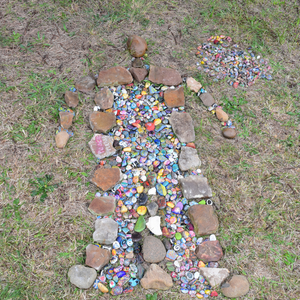Rockwood Rocks Remembrance (2022)
Painted rocks

Many cultures around the world use rocks as a way of emphasising the spirit living on eternally. This installation is about using rocks to remember those who have died. The form of the installation is an outline of a person; it is made with rocks placed on the ground. By picking up and placing a small stone inside the form, we are filling in that feeling of someone leaving us, whilst acknowledging that one can never replace that person. This form is about all humanity - each stone is unique, with each artist decorating or writing a message to their departed.
To participate:
- Choose a rock.
- Hesitate. Meditate. Contemplate.
- Place rock into the human form.
About the Artist

CAT (Cumberland Artists Together) meets on Dharug Country in Western Sydney. CAT is a collaborative initiative of artists, curators and craftspeople with a connection to the Cumberland Local Government Area in Sydney’s West. The CAT members have a range of exhibition and art residency experiences, are winners of an array of art and photography awards, and have an inclusive approach to supporting artists in their artistic practice and exhibitions.
Artists: Francisca Siow, Janice Irwin, Lesley Richman, Marina Robins, Michaela Simoni, Michelle Tran, Ruwaydah Rhodes, Seher Aydinlik, Shirley Jenkins, Trish Jean
Transcription
Hi, my name's Michaela Simoni and the main person in the group called CAT, and that stands for Cumberland Artists Together, and we put forward an application for the HIDDEN exhibition at Rookwood Cemetery. What our collective work, is called as Rookwood Rocks.
The artwork's name is Rookwood Rocks. It is going to be made from an outline of using large rocks on the ground and filled in with small rocks which are going to be placed by the participants. They're going to pick up a rock, which has all been painted and choose a rock that they like and then contemplate or say a prayer and then place it within the form. The form is going to be a form of a human being lying down on the ground and there's going to be a space in the middle, which is going to be formed by wire and which we cannot place in the rocks.
That is to first think about what is the most meaning for a symbol that can be used to describe grief, what is common throughout the world and a common denominator. We've played around with rocks. First of all. I had the idea of just the rocks, the large flat rocks just forming like a form, you know, to look like you just come across it in the bushland, and you started thinking of why was those rocks placed in that shape of a human the rocks have been each one is very done as an individual. None of them are an artwork. We are not artworks. So it there's some quick splashes of pain and someone might be remembering their grandmother, who liked roses, so they might find the one with the flower. And you can have layers of rocks just it's like there's layers of humanity.
It's just not one layer, but over the history you have one rock on top of the other. And so to do with the overall pattern, not say not one particular rock, that we all contribute in our special ways to humanity. But there's an area in the middle which is going to be set empty. That's symbolizes the fact that doesn't matter how much you think about somebody, how much you pray or meditate, you cannot bring that person back. The sense of loss which is and it feels like a hole in your heart. That's something when you lose somebody.
Well, a few years ago and before COVID, when I put it in the cut off the they wanted something about grief, so the the absence in the middle is to do with the grief, grieving process. I was thinking about how they even the tombstones are made of a lot of them are made of stone. So it's just another elaborated form of a stone. Stone symbolizes that the presence of somebody doesn't go that the that it stays through time. It was amazing when I was doing my research, is to find out the pile of rocks. How that is so universal. That's there's some aboriginal tribes which use it in Queensland and then you have the Irish have a pile of rocks.
Use a pile of rocks too. Somebody dies in the in the Celtic tradition, and then have in Canada and in the native Americans. So without anybody the idea being spread by word. That how it was inherent in us to use stones. So in Rookwood Cemetery, of course we're surrounded by stones in the shape of tombstones, contemplation, that they came and they contemplated and that they contributed to the work, that life is an ongoing process and that that everyone is important, even though we're just the size of a pebble in reality.
Just to think about the meaning of life, the meaning of that we contributed to it, to the world in our own small way. And again the idea that, going back to the Jewish tradition where they just put the pebble on the tombstone, is a reminder that they also came there and they thought about that person and left something behind.